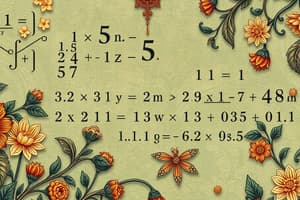Podcast
Questions and Answers
How is the algebra taught in early childhood different from the algebra studied in high school or college?
How is the algebra taught in early childhood different from the algebra studied in high school or college?
The algebra taught will focus on helping children form generalizations from their experiences with numbers and computation techniques, using different representations including symbols.
What is different about the algebra I learned in high school?
What is different about the algebra I learned in high school?
It involved many variables and was much more abstract, focusing on memorization of equations to solve problems.
What do children need to form generalizations?
What do children need to form generalizations?
They need to be given many examples and form commonalities that can be used to describe them.
What are the three strands of algebraic thinking that help children with generalizations and symbolism?
What are the three strands of algebraic thinking that help children with generalizations and symbolism?
What are three generalizations with the structure of the number system?
What are three generalizations with the structure of the number system?
What do children learn through generalizations with number combinations?
What do children learn through generalizations with number combinations?
What strategies do children learn for adding and subtracting using place value?
What strategies do children learn for adding and subtracting using place value?
What is the focus of generalizations with algorithms?
What is the focus of generalizations with algorithms?
What understanding do children need regarding the properties of computations?
What understanding do children need regarding the properties of computations?
How do children develop an understanding of even and odd numbers?
How do children develop an understanding of even and odd numbers?
What is the purpose of the 'Fair Shares of Two' activity?
What is the purpose of the 'Fair Shares of Two' activity?
What is the significance of understanding the equal sign?
What is the significance of understanding the equal sign?
What does operational thinking about the equal sign involve?
What does operational thinking about the equal sign involve?
How does relational computational thinking view the equal sign?
How does relational computational thinking view the equal sign?
What is relational structural thinking regarding the equal sign?
What is relational structural thinking regarding the equal sign?
What activity helps illustrate the concept of equations being equal using a balance scale?
What activity helps illustrate the concept of equations being equal using a balance scale?
What are variables used as unknown values?
What are variables used as unknown values?
What is the role of patterns in algebraic thinking?
What is the role of patterns in algebraic thinking?
Why is studying patterns important in early grades?
Why is studying patterns important in early grades?
What are repeating patterns?
What are repeating patterns?
What do growing patterns involve?
What do growing patterns involve?
What does functional thinking involve?
What does functional thinking involve?
What does the use of a 'function machine' help children develop?
What does the use of a 'function machine' help children develop?
What are number patterns?
What are number patterns?
What are misconceptions about algebraic thinking?
What are misconceptions about algebraic thinking?
Flashcards are hidden until you start studying
Study Notes
Early Childhood Algebra vs. Higher Education Algebra
- Early childhood algebra emphasizes forming generalizations from experiences with numbers rather than focusing on abstract variables.
- The teaching approach involves concrete models and experiential learning rather than rote memorization.
Generalizations Required for Algebraic Thinking
- Children need multiple examples to find commonalities that help in forming generalizations about numbers.
- Key strands of algebraic thinking include:
- Identifying generalizations in the number system.
- Studying patterns, relations, and functions.
- Engaging in meaningful mathematical modeling, including symbol use.
Key Number System Generalizations
- Understanding combinations of numbers, place value, and algorithms to comprehend computation properties.
- Recognition of even and odd numbers helps children explore the structure of the number system.
Generalizations with Specific Examples
- Number combinations: Techniques for understanding addition/subtraction relationships (e.g., 12 - 8 = 10 - 6).
- Place value: Strategies for adding and subtracting using multiples of ten.
- Algorithms: Identifying effective strategies for different types of math problems.
Understanding Computation Properties
- Emphasis on applying properties such as commutative and associative without merely identifying them.
- Encourages children to recognize patterns and express findings using their own words.
Conceptualizing Even and Odd Numbers
- Concept of even numbers: Can be shared fairly; no leftovers.
- Concept of odd numbers: Cannot be equally divided into two groups.
Fair Share Activity
- Engages students in understanding even and odd numbers using real-life sharing scenarios (e.g., seashells or cookies).
- Encourages collaborative exploration of numbers and promotes conceptual definitions over mere counting.
Meaningful Use of Symbols
- Importance of establishing a solid understanding of arithmetic symbols and the equal sign.
- Misconceptions often arise regarding the equal sign, which should represent equivalency rather than merely the notion of an answer.
Types of Thinking Related to the Equal Sign
- Operational thinking: Viewing the equal sign as a prompt to calculate.
- Relational computational thinking: Recognizing a relationship between calculations but focusing solely on computation.
- Relational structural thinking: Understanding numeric relationships without actual computation.
Engaging Algebraic Activities
- Ten and Then Some: Children determine sums using equations on note cards and write equivalent expressions.
- Different but the Same: Exploring various equations that equal the same number, reinforcing the concept of equivalency.
Understanding and Distinguishing Variables
- Variables: Used as placeholders (unknown values) or represent quantities that can vary.
- Fundamental to developing algebraic thinking by representing specific and multiple values.
Importance of Patterns in Algebraic Thinking
- Patterns in math promote algebraic understanding and include:
- Repeating patterns: Identifying core patterns that repeat.
- Growing patterns: Focus on relationships and changes within sequences.
- Functional thinking: Understanding inputs and outputs, exploring consistent changes.
Function Machine Activity
- Enhances functional thinking through input-output relationships, where children guess functions based on given rules.
- Engages children in understanding rules through cooperative learning and analysis.
Recognizing Number Patterns
- Aids in understanding relationships between numbers and foundations of place value.
- Exploring skip counting provides insights into familiar numerical patterns and inventing strategies.
Common Misconceptions in Algebraic Thinking
- Misunderstanding the equal sign as merely prompting action.
- Limited checking of algebraic concepts leads to overgeneralization of rules.
- Confusing variable labels and their applications.
These frameworks and activities foster a foundational understanding of algebraic reasoning in early childhood education through engagement, exploration, and relational thinking.
Studying That Suits You
Use AI to generate personalized quizzes and flashcards to suit your learning preferences.



